Predicting Urban Vitality at Regional Scales: A Deep Learning Approach to Modelling Population Density and Pedestrian Flows
Abstract
Highlights
- The UVPN model’s innovative architecture—integrating SE block and RCA bottleneck—effectively captures intricate spatial relationships and feature interdependencies, surpassing conventional deep learning models in urban vitality prediction.
- Static and dynamic urban vitality are shaped by distinct spatial features: macro-scale road networks influence regional residential patterns, micro-scale streetscape elements drive localized pedestrian activity, and meso-scale factors such as built density and POI distribution influence both—highlighting the multi-layered nature of urban vibrancy.
- The model’s ability to produce fine-grained, dual-dimensional vitality maps helps uncover how different scales of urban form—from regional infrastructure to local design—affect where and how people live and move.
- UVPN provides urban planners and policymakers a powerful tool for evidence-based decision-making, supporting the design of targeted interventions at multiple spatial scales to create more sustainable, functional, and livable cities.
Abstract
1. Introduction
- (1)
- This study aims to create a unified computational framework that simultaneously predicts both static (e.g., population density) and dynamic (e.g., pedestrian flow) dimensions of urban vitality. This dual-dimensional approach addresses the limitation of single-metric models by providing a more holistic understanding of human activity patterns, capturing both long-term residential patterns and short-term street-level dynamics.
- (2)
- The study seeks to overcome the constraints of discrete sampling points by producing continuous spatial distributions of urban vitality at fine granularity. Leveraging advanced deep-learning techniques, the UVPN model aims to capture both localized variations and broader regional trends, enabling high-resolution predictions crucial for informed urban planning and management.
- (3)
- This study aims to design a model that performs reliably across diverse and heterogeneous urban environments. By integrating encoder-decoder architecture with advanced attention mechanisms—specifically, the SE (squeeze-and-excitation) block and the RCA (residual connection with coordinate attention) bottleneck—the UVPN model is designed to adaptively recalibrate feature importance and capture position-aware spatial relationships. This ensures robust performance in capturing the complex interplay between urban morphological features and vitality patterns, even in highly varied urban contexts.
2. Literature Review
2.1. Urban Vitality Concepts and Measurement
2.2. Urban Vitality Models
2.3. Research Gaps
3. Methodology
3.1. Methodology Framework and Problem Formulation
3.2. UVPN Model
3.2.1. SE-Based Encoder
3.2.2. RCA-Based Bottleneck
- Residual learning: The residual block employs the principle of residual learning to facilitate adaptive feature refinement while addressing degradation issues in deep networks. For an input feature map , the residual transformation is applied through a sequence of convolutional layer (), batch normalization layer (), and ReLU activation (), defined as:
- Coordinate information embedding: To capture long-range spatial dependencies and encode precise positional information, the coordinate attention mechanism embeds direction-aware information through separate horizontal and vertical pathways. These pathways employ pooling operations with kernels or to extract position-sensitive information along the height and width dimensions to highlight objects of interest. For the channel, the pooled outputs (height-specific) and (width-specific) are computed as:
- Coordinate attention generation: The embedded coordinate information is used to generate attention maps that emphasize spatially and contextually significant relationships among features. This process enhances the network’s ability to capture interdependencies across spatial positions and channels, offering adaptive weightings that reflect the importance of different feature combinations. The attention generation involves the following steps: (a) The pooled feature maps and are concatenated to create an intermediate feature map , which encoders channel-spatial dependencies by capturing feature interactions across horizontal and vertical dimensions (Equation (7)). (b) The intermediate map is split into two separate components: for horizontal attention and for vertical attention. (c) Both and are expanded to match the original spatial dimensions, generating attention maps and that adaptively weight the features by leveraging their spatial positions and inter-channel relationships (Equations (8) and (9)). (d) Finally, the output is computed by modulating the input features with the corresponding attention weights and (Equation (10)).
3.2.3. Decoder
4. Experiments
4.1. Data Collection
4.2. Data Preprocessing
4.2.1. Label Preprocessing
4.2.2. Feature Preprocessing
- Numerical features: The preprocessing of numerical features aligns closely with the label processing pipeline. Unlike conventional methods relying on statistical summaries, this study represents streetscape and POI features as continuous spatial distributions to provide a more dynamic and functional characterization of urban environments. Streetscape attributes, such as building facades, vegetation coverage, and sidewalk ratios, are extracted from Google Street View imagery using SegFormer for semantic segmentation. These point-based measurements are spatially interpolated into continuous feature maps using the IDW method, effectively capturing their spatial distributions and regional effects. POI data are processed using two complementary techniques: kernel density estimation with adaptive bandwidth selection to generate density features, and network-based calculations to compute accessibility metrics as distances to the nearest facility for each POI category. To ensure consistency and enhance model generalizability, all numerical features undergo a relative value transformation using Equation (12), normalizing them relative to their regional median, consistent with the label processing strategy.
- Categorical features: Categorical features are processed through a one-hot encoding scheme, transforming discrete spatial attributes into a multi-channel representation optimized for deep learning networks. This encoding method generates binary feature channels, where a value of 1 indicates the presence of a specific attribute and 0 indicates its absence. As shown in Figure 7, land use patterns are encoded into 11 channels, representing key urban functions such as mixed, commercial, industrial, and other categories. Similarly, road networks are encoded into 8 channels to capture hierarchical street classifications and network topology. This encoding strategy not only preserves the categorical nature of urban elements but also retains their spatial relationships, enabling seamless integration with deep learning models for effective feature learning and vitality prediction.
4.3. Model Training and Evaluation
4.4. Results
4.4.1. Model Performance
4.4.2. Feature Importance
4.5. Performance Comparison
4.5.1. Algorithm Comparison
4.5.2. Model Performance in NYC Boroughs
4.6. Discussion
5. Conclusions
6. Declaration of Generative AI and AI-Assisted Technologies in the Writing Process
Author Contributions
Funding
Data Availability Statement
Conflicts of Interest
References
- Jiang, F.; Ma, J.; Li, Z. Pedestrian volume prediction with high spatiotemporal granularity in urban areas by the enhanced learning model. Sustain. Cities Soc. 2022, 79, 103653. [Google Scholar] [CrossRef]
- Zhang, Z.; Liu, J.; Wang, C.; Zhao, Y.; Zhao, X.; Li, P.; Sha, D. A spatial projection pursuit model for identifying comprehensive urban vitality on blocks using multisource geospatial data. Sustain. Cities Soc. 2024, 100, 104998. [Google Scholar] [CrossRef]
- Wu, C.; Ye, Y.; Gao, F.; Ye, X. Using street view images to examine the association between human perceptions of locale and urban vitality in Shenzhen, China. Sustain. Cities Soc. 2023, 88, 104291. [Google Scholar] [CrossRef]
- Chen, Y.; Yu, B.; Shu, B.; Yang, L.; Wang, R. Exploring the spatiotemporal patterns and correlates of urban vitality: Temporal and spatial heterogeneity. Sustain. Cities Soc. 2023, 91, 104440. [Google Scholar] [CrossRef]
- Yahia, O.; Chohan, A.H.; Arar, M.; Awad, J. Toward Sustainable Urban Mobility: A Systematic Review of Transit-Oriented Development for the Appraisal of Dubai Metro Stations. Smart Cities 2025, 8, 21. [Google Scholar] [CrossRef]
- Tamagusko, T.; Gomes Correia, M.; Rita, L.; Bostan, T.-C.; Peliteiro, M.; Martins, R.; Santos, L.; Ferreira, A. Data-Driven Approach for Urban Micromobility Enhancement through Safety Mapping and Intelligent Route Planning. Smart Cities 2023, 6, 2035–2056. [Google Scholar] [CrossRef]
- Jiang, F.; Ma, J. A comprehensive study of macro factors related to traffic fatality rates by XGBoost-based model and GIS techniques. Accid. Anal. Prev. 2021, 163, 106431. [Google Scholar] [CrossRef]
- Papageorgiou, G.N.; Demetriou, D.; Tsappi, E.; Maimaris, A. Analyzing the Requirements for Smart Pedestrian Applications: Findings from Nicosia, Cyprus. Smart Cities 2024, 7, 1950–1970. [Google Scholar] [CrossRef]
- Garus, A.; Mourtzouchou, A.; Suarez, J.; Fontaras, G.; Ciuffo, B. Exploring Sustainable Urban Transportation: Insights from Shared Mobility Services and Their Environmental Impact. Smart Cities 2024, 7, 1199–1220. [Google Scholar] [CrossRef]
- Brodny, J.; Tutak, M.; Bindzár, P. Measuring and Assessing the Level of Living Conditions and Quality of Life in Smart Sustainable Cities in Poland—Framework for Evaluation Based on MCDM Methods. Smart Cities 2024, 7, 1221–1260. [Google Scholar] [CrossRef]
- Jiang, F.; Yuen, K.K.R.; Lee, E.W.M. A long short-term memory-based framework for crash detection on freeways with traffic data of different temporal resolutions. Accid. Anal. Prev. 2020, 141, 105520. [Google Scholar] [CrossRef] [PubMed]
- Parygin, D.; Anokhin, A.; Anikin, A.; Finogeev, A.; Gurtyakov, A. Models of Geospatially Referenced People Distribution as a Basis for Studying the Daily Cycles of Urban Infrastructure Use by Residents. Smart Cities 2025, 8, 1. [Google Scholar] [CrossRef]
- Correa, F.; Bartorila, M.; Ribeiro-Palacios, M.; Pérez-Soto, G.I.; Rodríguez-Reséndiz, J. Toward the Human Scale in Smart Cities: Exploring the Role of Active Mobility in Ecosystemic Urbanism. Smart Cities 2024, 7, 4002–4024. [Google Scholar] [CrossRef]
- Xu, N.; Zhang, X.; Wang, P. Public Vitality-Driven Optimization of Urban Public Space Networks—A Case Study from Nanjing, China. Smart Cities 2025, 8, 18. [Google Scholar] [CrossRef]
- Moro-Araujo, A.; Alonso Pastor, L.; Larson, K. Modeling Strategic Interventions to Increase Attendance at Youth Community Centers. Smart Cities 2024, 7, 1878–1887. [Google Scholar] [CrossRef]
- Itair, M.; Shahrour, I.; Hijazi, I. The Use of the Smart Technology for Creating an Inclusive Urban Public Space. Smart Cities 2023, 6, 2484–2498. [Google Scholar] [CrossRef]
- Jiang, F.; Yuen, K.K.R.; Lee, E.W.M. Analysis of motorcycle accidents using association rule mining-based framework with parameter optimization and GIS technology. J. Saf. Res. 2020, 75, 292–309. [Google Scholar] [CrossRef]
- Schuhmann, F.; Nguyen, N.A.; Schweizer, J.; Huang, W.-C.; Lienkamp, M. Creating and Validating Hybrid Large-Scale, Multi-Modal Traffic Simulations for Efficient Transport Planning. Smart Cities 2025, 8, 2. [Google Scholar] [CrossRef]
- Zini, A.; Roberto, R.; Corrias, P.; Felici, B.; Noussan, M. Accessibility Measures to Evaluate Public Transport Competitiveness: The Case of Rome and Turin. Smart Cities 2024, 7, 3334–3354. [Google Scholar] [CrossRef]
- Wu, J.; Lu, Y.; Gao, H.; Wang, M. Cultivating historical heritage area vitality using urban morphology approach based on big data and machine learning. Computers. Environ. Urban Syst. 2022, 91, 101716. [Google Scholar] [CrossRef]
- Jiang, F.; Ma, J. Environmental Justice in the 15-Minute City: Assessing Air Pollution Exposure Inequalities Through Machine Learning and Spatial Network Analysis. Smart Cities 2025, 8, 53. [Google Scholar] [CrossRef]
- Chen, W.; Wu, A.N.; Biljecki, F. Classification of urban morphology with deep learning: Application on urban vitality, Computers. Environ. Urban Syst. 2021, 90, 101706. [Google Scholar] [CrossRef]
- Jiang, F.; Ma, J.; Li, Z.; Ding, Y. Prediction of energy use intensity of urban buildings using the semi-supervised deep learning model. Energy 2022, 249, 123631. [Google Scholar] [CrossRef]
- Wang, Z.; Wang, X.; Liu, Y.; Zhu, L. Identification of 71 factors influencing urban vitality and examination of their spatial dependence: A comprehensive validation applying multiple machine-learning models. Sustain. Cities Soc. 2024, 108, 105491. [Google Scholar] [CrossRef]
- Doan, Q.C.; Ma, J.; Chen, S.; Zhang, X. Nonlinear and threshold effects of the built environment, road vehicles and air pollution on urban vitality. Landsc. Urban Plan. 2025, 253, 105204. [Google Scholar] [CrossRef]
- Jacobs, J. The Death and Life of Great American Cities, Reissue edition; Vintage: New York, NY, USA, 1992. [Google Scholar]
- Doan, Q.C. The spatiotemporal trends of urban-rural green spaces and their heterogeneous relationships with population and economic vitality: Evidence from the Red River Delta, Vietnam. Socio-Econ. Plan. Sci. 2024, 93, 101885. [Google Scholar] [CrossRef]
- Sun, Y.; You, X. Do digital inclusive finance, innovation, and entrepreneurship activities stimulate vitality of the urban economy? Empirical evidence from the Yangtze River Delta, China. Technol. Soc. 2023, 72, 102200. [Google Scholar] [CrossRef]
- Lee, S.; Kang, J.E. Impact of particulate matter and urban spatial characteristics on urban vitality using spatiotemporal big data. Cities 2022, 131, 104030. [Google Scholar] [CrossRef]
- Zhang, Y.; Tu, T.; Long, Y. Inferring ghost cities on the globe in newly developed urban areas based on urban vitality with multi-source data. Habitat Int. 2025, 158, 103350. [Google Scholar] [CrossRef]
- Guo, Z.; Luo, K.; Yan, Z.; Hu, A.; Wang, C.; Mao, Y.; Niu, S. Assessment of the street space quality in the metro station areas at different spatial scales and its impact on the urban vitality. Front. Archit. Res. 2024, 13, 1270–1287. [Google Scholar] [CrossRef]
- Chen, M.; Cai, Y.; Guo, S.; Sun, R.; Song, Y.; Shen, X. Evaluating implied urban nature vitality in San Francisco: An interdisciplinary approach combining census data, street view images, and social media analysis. Urban For. Urban Green. 2024, 95, 128289. [Google Scholar] [CrossRef]
- Jiang, F.; Ma, J.; Webster, C.J.; Chen, W.; Wang, W. Estimating and explaining regional land value distribution using attention-enhanced deep generative models. Comput. Ind. 2024, 159–160, 104103. [Google Scholar] [CrossRef]
- Jiang, F.; Ma, J.; Webster, C.J.; Li, X.; Gan, V.J.L. Building layout generation using site-embedded GAN model. Autom. Constr. 2023, 151, 104888. [Google Scholar] [CrossRef]
- Jiang, F.; Ma, J.; Webster, C.J.; Wang, W.; Cheng, J.C.P. Automated site planning using CAIN-GAN model. Autom. Constr. 2024, 159, 105286. [Google Scholar] [CrossRef]
- Jiang, F.; Ma, J.; Webster, C.J.; Chiaradia, A.J.F.; Zhou, Y.; Zhao, Z.; Zhang, X. Generative urban design: A systematic review on problem formulation, design generation, and decision-making. Prog. Plan. 2024, 180, 100795. [Google Scholar] [CrossRef]
- Hu, J.; Shen, L.; Sun, G.; Albanie, S.; Wu, E. Squeeze-and-Excitation Networks. arXiv 2018, arXiv:1709.01507. [Google Scholar] [CrossRef]
- Hou, Q.; Zhou, D.; Feng, J. Coordinate Attention for Efficient Mobile Network Design. arXiv 2021, arXiv:2103.02907. [Google Scholar] [CrossRef]
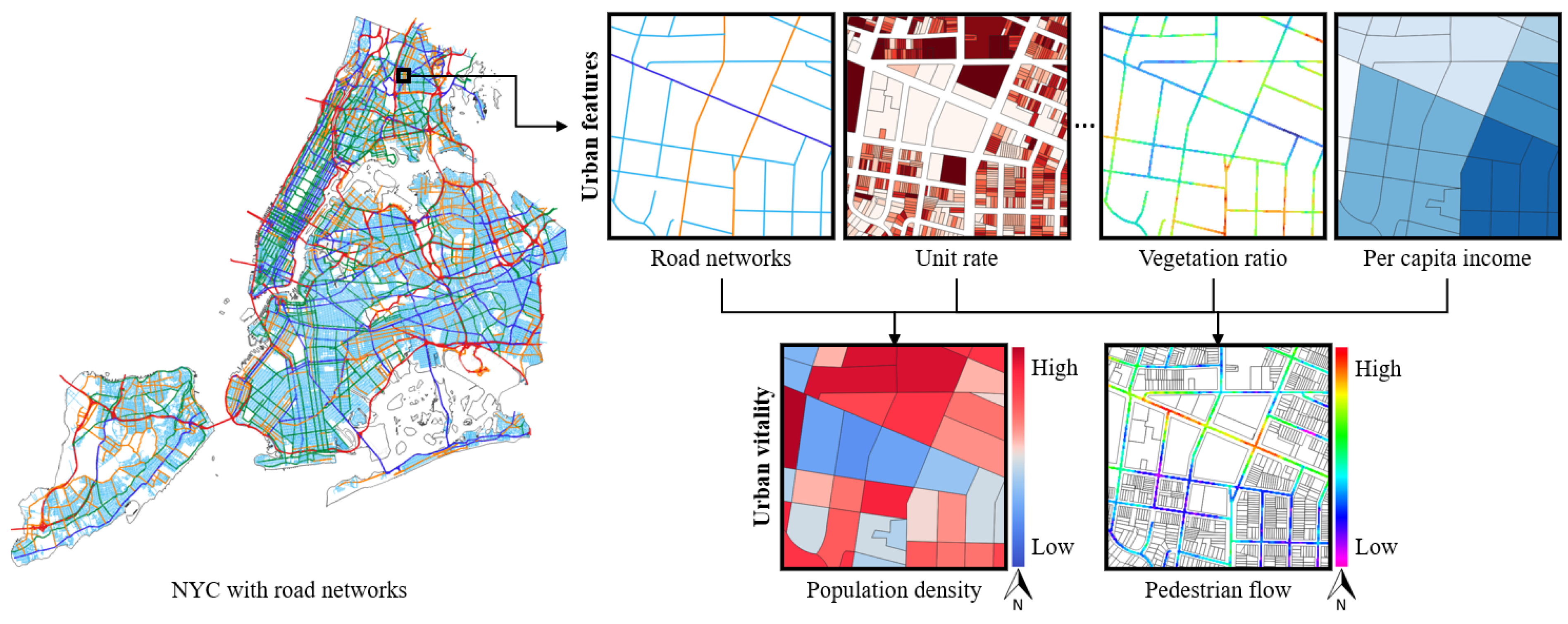
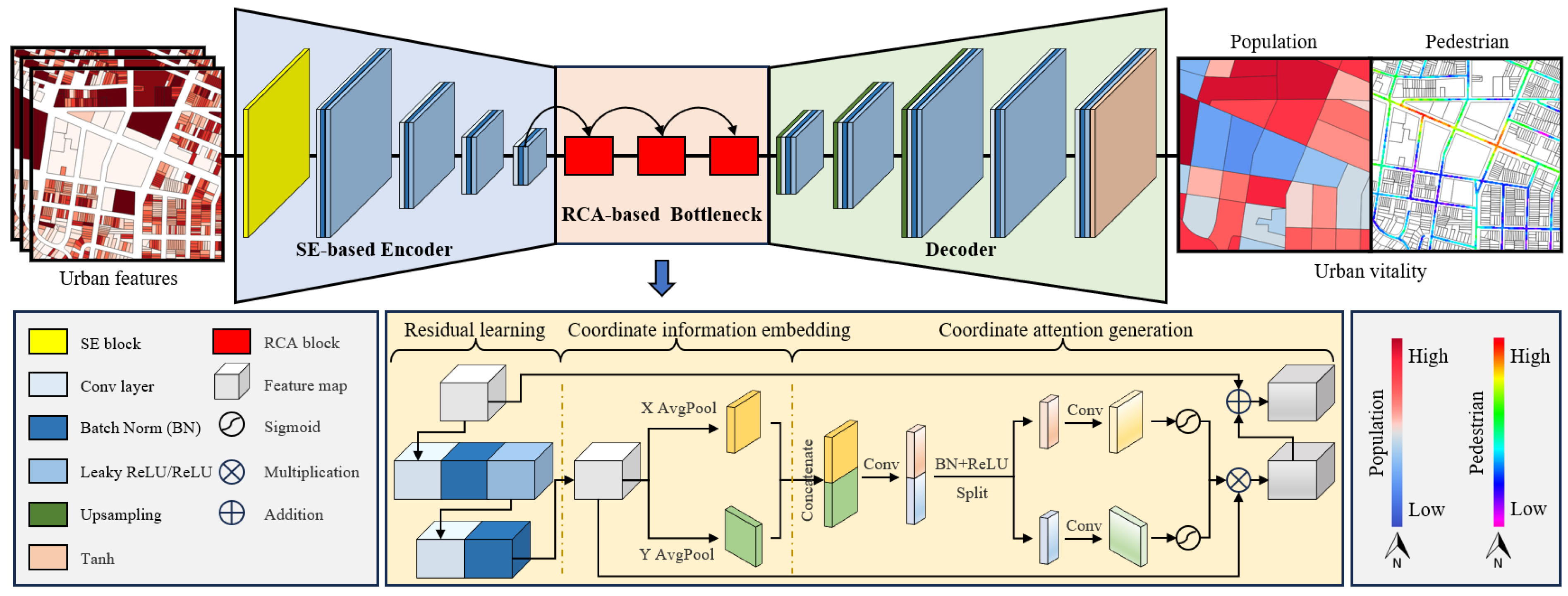
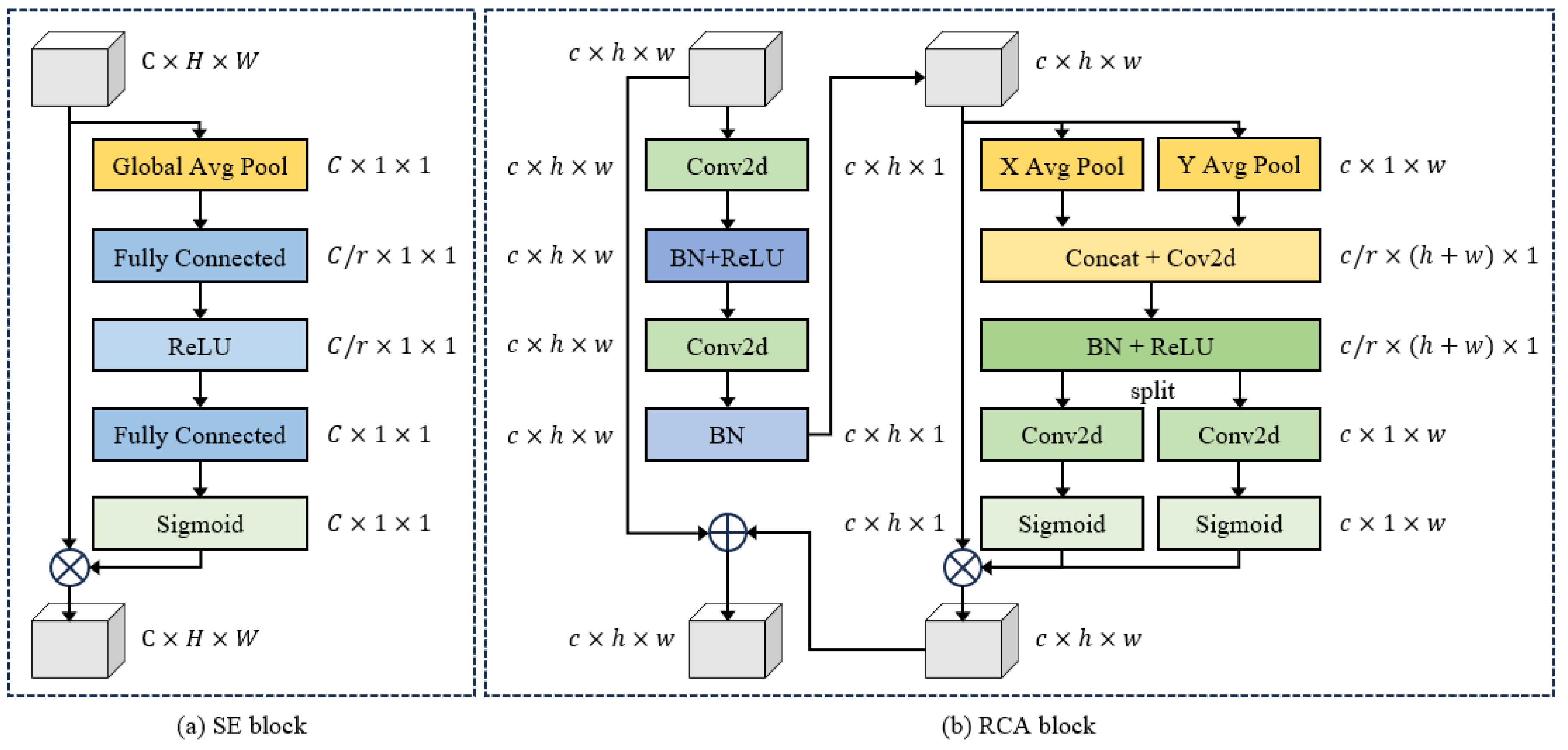
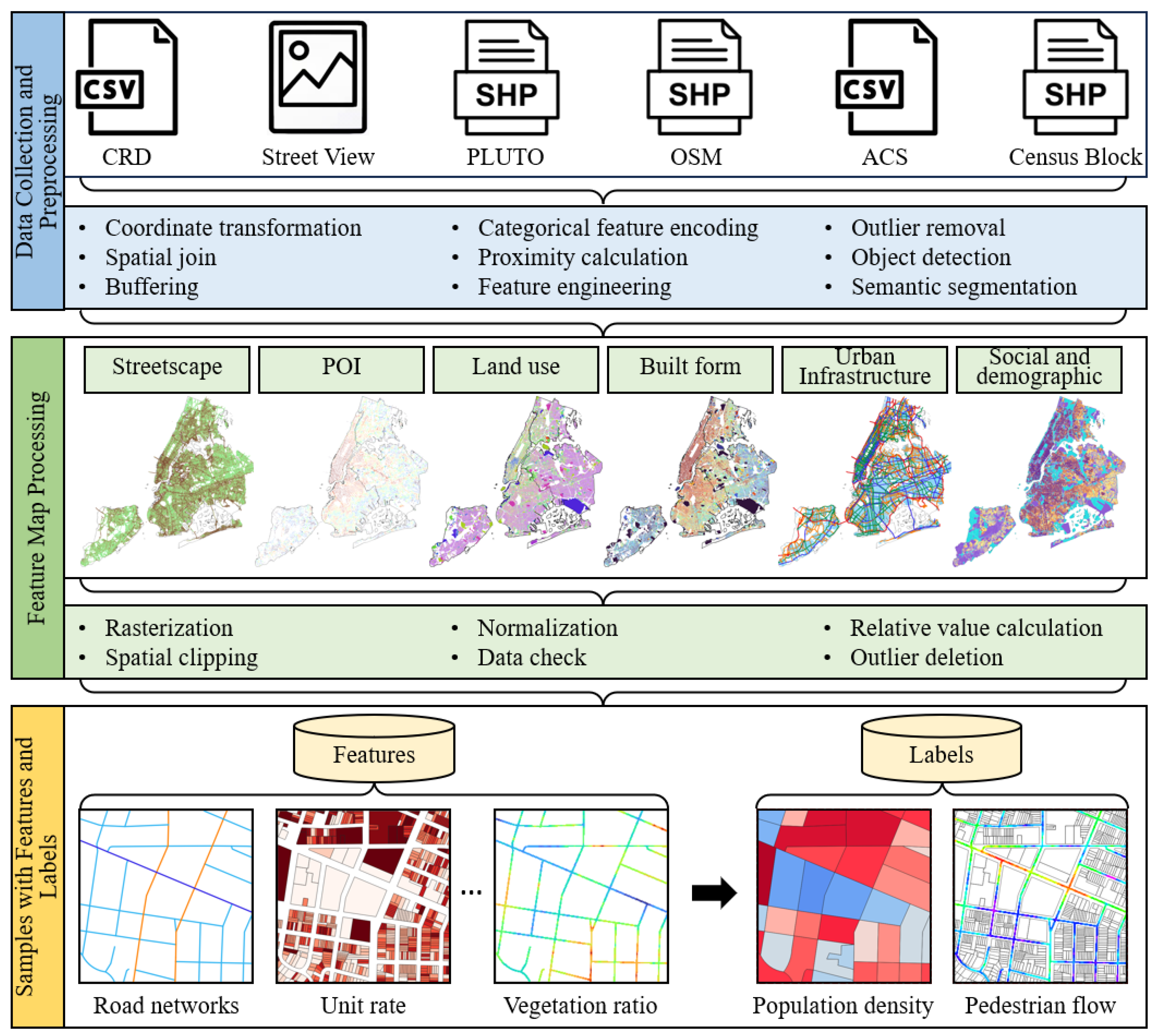
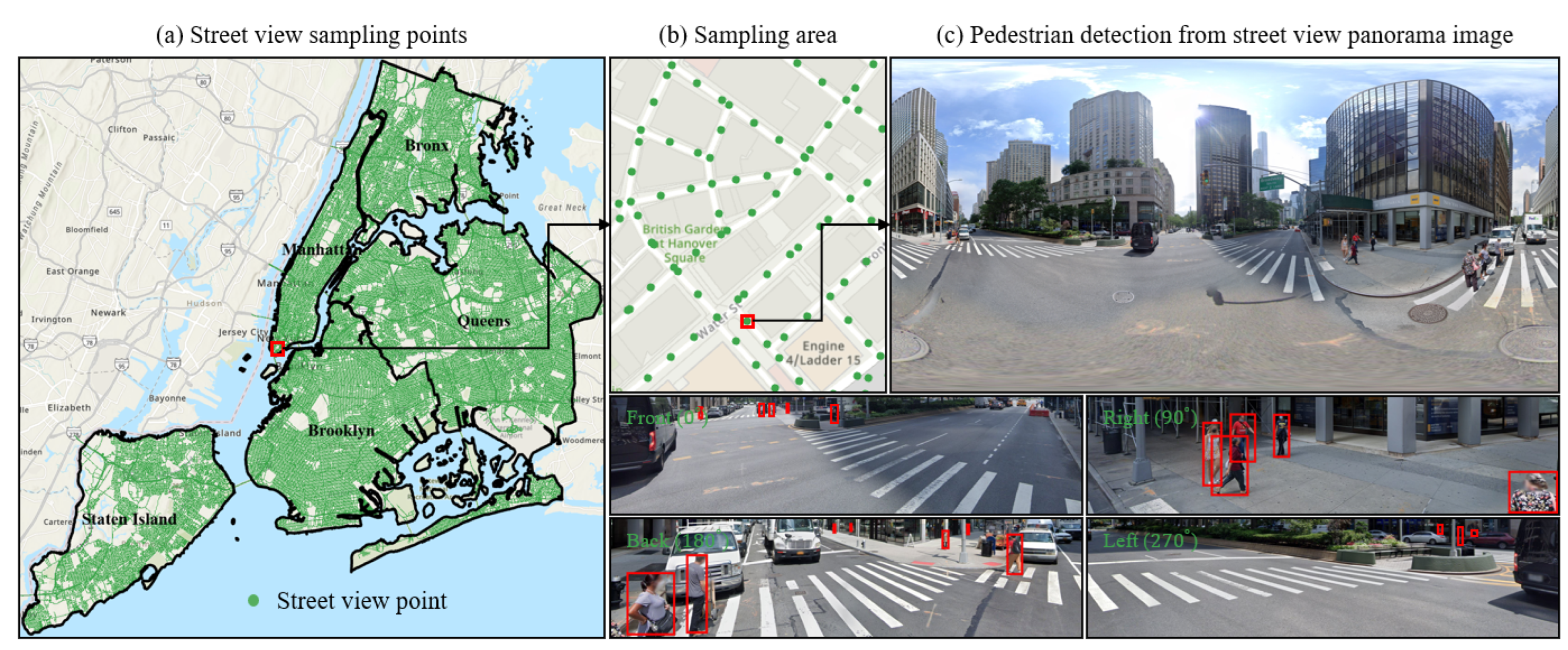
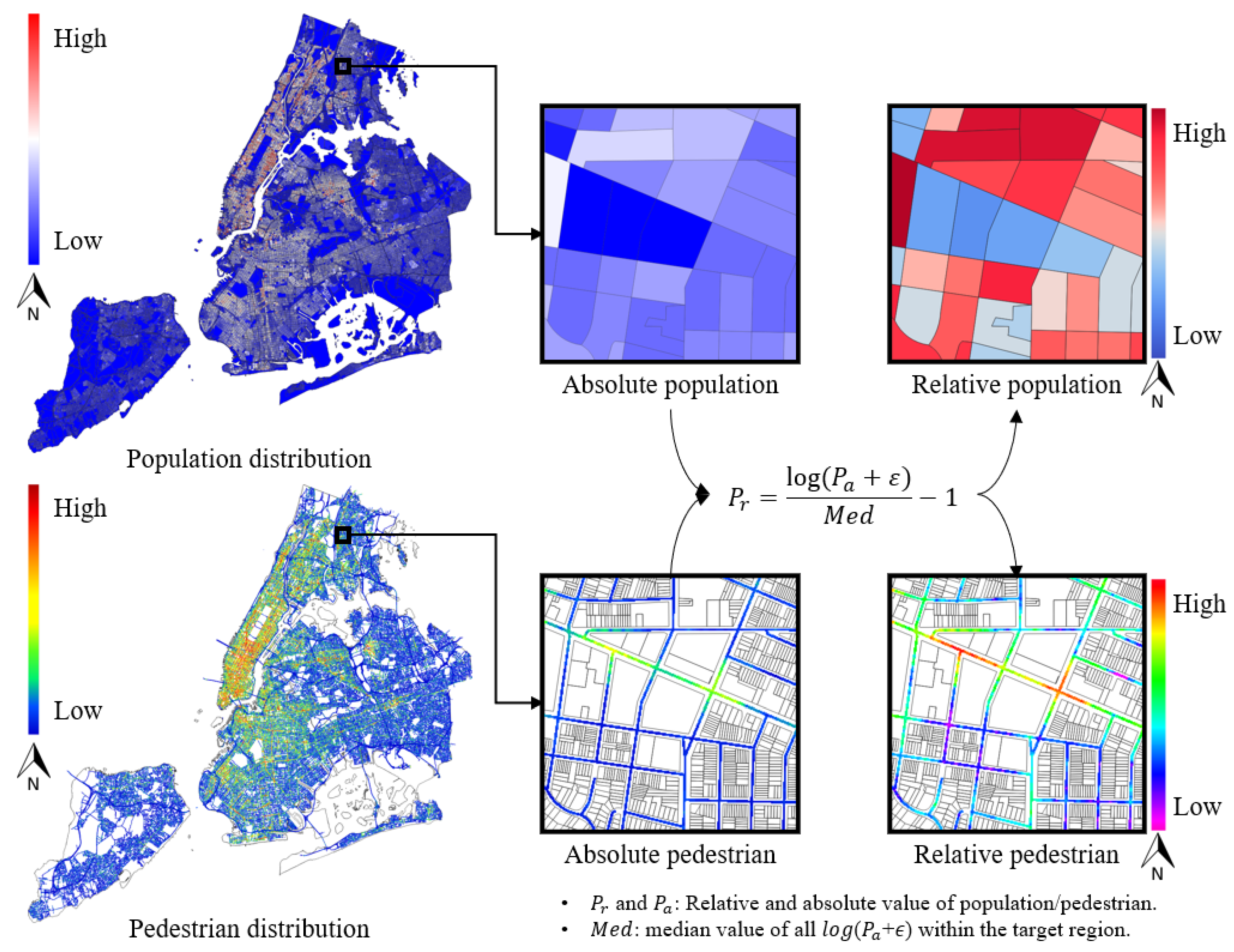
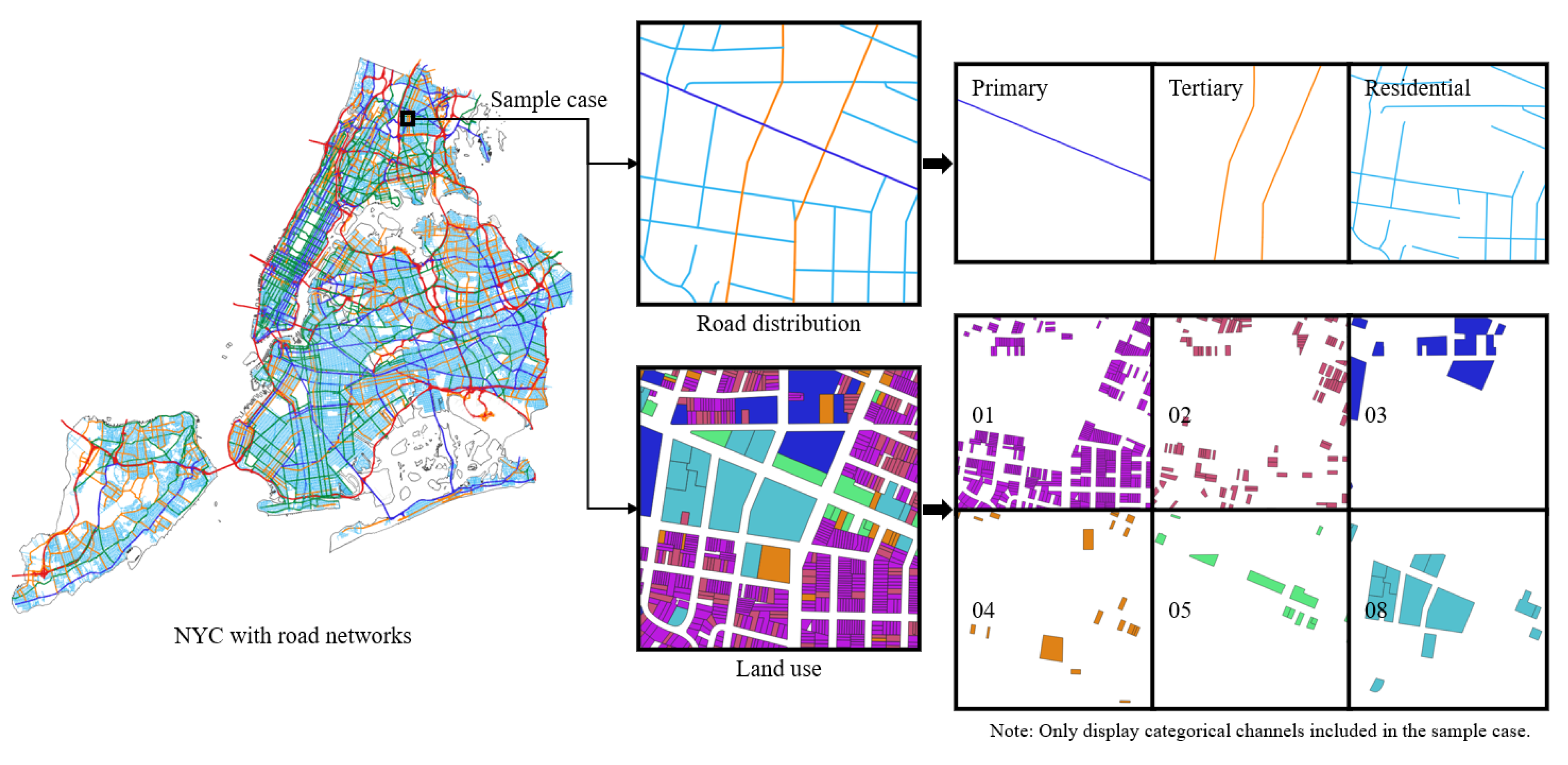


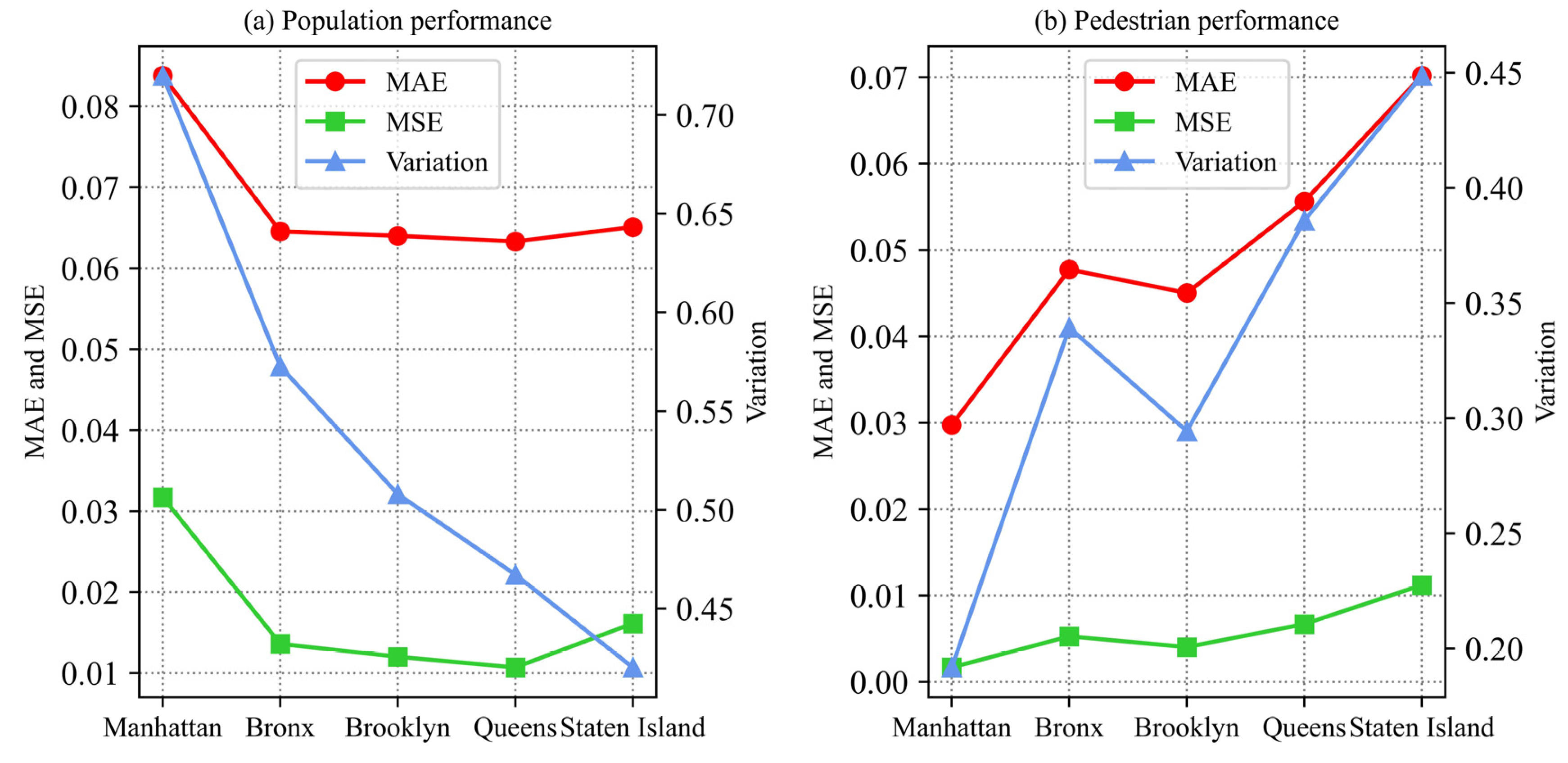
| Dataset | Spatial Resolution | Data Format | Source |
|---|---|---|---|
| CRD | Census block (CB) | Tables | U.S. Census Bureau, Suitland, MD, USA. URL: https://www.census.gov/ (accessed on 10 June 2024) |
| Google Street View | Road | Images | Google Map. URL: https://www.google.com/streetview/ (accessed on 10 June 2024) |
| PLUTO | Borough, block, and lot (BBL) | Shapefiles | NYC Department of City Planning, NY, USA. URL: https://www.nyc.gov/ (accessed on 10 June 2024) |
| OSM | Road, point | Shapefiles | OpenStreetMap. URL: https://www.openstreetmap.org/ (accessed on 10 June 2024) |
| ACS | Census tract (CT) | Tables | U.S. Census Bureau, Suitland, MD, USA. URL: https://www.census.gov/ (accessed on 10 June 2024) |
| Census Block | CB | Shapefiles | NYC OpenData. URL: https://opendata.cityofnewyork.us/ (accessed on 10 June 2023) |
| Variable | Representative Features | Resolution | Number |
|---|---|---|---|
| Streetscape | Building, vegetation, road, sky, sidewalk | Road | 5 |
| POI | Density (e.g., transportation, healthcare), nearest distance (e.g., entertainment, shop) | Road | 28 |
| Land use | Zoning district (e.g., residential, commercial, mixed), land use type (1–11) | BBL | 15 |
| Built form | Built FAR, number of buildings | BBL | 6 |
| Urban infrastructure | Road types (e.g., motorway, primary), green | Road/BBL | 9 |
| Social and demographic | Employment rate, per capita income | CB/CT | 4 |
| Total | 67 | ||
| Model | Pop.MAE | Pop.MSE | Pop.SSIM | Pop.PSNR | Ped.MAE | Ped.MSE | Ped.SSIM | Ped.PSNR |
|---|---|---|---|---|---|---|---|---|
| U-Net | 0.0782 | 0.0258 | 0.6385 | 18.7414 | 0.0751 | 0.0125 | 0.9711 | 20.9040 |
| EncoDeco (ResBlock) | 0.0752 | 0.0257 | 0.6462 | 18.9604 | 0.0560 | 0.0070 | 0.9766 | 23.1318 |
| EncoDeco (SE and ResBlock) | 0.0729 | 0.0223 | 0.6471 | 19.2200 | 0.0508 | 0.0061 | 0.9776 | 23.7659 |
| UVPN | 0.0679 | 0.0162 | 0.6479 | 20.0128 | 0.0480 | 0.0052 | 0.9784 | 24.2188 |
| Improvement | 9.94% | 34.03% | 0.62% | 5.48% | 20.81% | 38.66% | 0.34% | 7.16% |
Disclaimer/Publisher’s Note: The statements, opinions and data contained in all publications are solely those of the individual author(s) and contributor(s) and not of MDPI and/or the editor(s). MDPI and/or the editor(s) disclaim responsibility for any injury to people or property resulting from any ideas, methods, instructions or products referred to in the content. |
© 2025 by the authors. Licensee MDPI, Basel, Switzerland. This article is an open access article distributed under the terms and conditions of the Creative Commons Attribution (CC BY) license (https://creativecommons.org/licenses/by/4.0/).
Share and Cite
Jiang, F.; Ma, J. Predicting Urban Vitality at Regional Scales: A Deep Learning Approach to Modelling Population Density and Pedestrian Flows. Smart Cities 2025, 8, 58. https://doi.org/10.3390/smartcities8020058
Jiang F, Ma J. Predicting Urban Vitality at Regional Scales: A Deep Learning Approach to Modelling Population Density and Pedestrian Flows. Smart Cities. 2025; 8(2):58. https://doi.org/10.3390/smartcities8020058
Chicago/Turabian StyleJiang, Feifeng, and Jun Ma. 2025. "Predicting Urban Vitality at Regional Scales: A Deep Learning Approach to Modelling Population Density and Pedestrian Flows" Smart Cities 8, no. 2: 58. https://doi.org/10.3390/smartcities8020058
APA StyleJiang, F., & Ma, J. (2025). Predicting Urban Vitality at Regional Scales: A Deep Learning Approach to Modelling Population Density and Pedestrian Flows. Smart Cities, 8(2), 58. https://doi.org/10.3390/smartcities8020058





